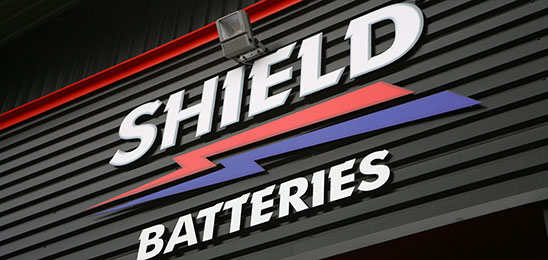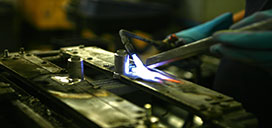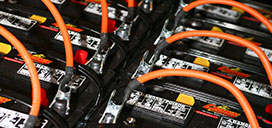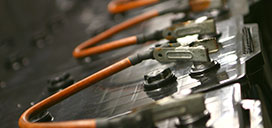ACID
Sulphuric Acid. This is the electrolyte or liquid contained in battery’s cells
ACTIVE MATERIAL
The active material in the positive plates of a battery is lead dioxide and that in the negative plates is metallic sponge lead. When an electrical circuit is created, these materials react with sulphuric acid during charging and discharging according to the following chemical reaction
PbO2 + Pb + 2H2SO4 = 2PbSO4 + 2H2O
ACTIVATION
Adding electrolyte to a dry battery.
AGM
Absorbed Glass Mat
AGM BATTERY
A battery that does not contain any free liquid electrolyte. The electrolyte is absorbed in glass mat material located in each of the battery’s cells. AGM and VRLA batteries are the same design
AMPERE (Amp., A.)
The unit of measure of the electron flow rate, or current, through a circuit
AMPERE-HOUR (Amp.-Hr., Ah.)
A unit of measurement for a battery’s electrical storage capacity, obtained by multiplying the current in amperes by the time of the hours of discharge. (For example, a battery which delivers 5 amperes for 20 hours delivers 5A x 20Hr = 100Ah of capacity)
ANTIMONY
A hard brittle silver-white metal with a high lustre from the arsenic family. Chemical formula Sb, atomic number 51.
CADMIUM
A metallic element, highly resistant to corrosion, used as protective plating on battery components. Chemical formula Cd, atomic number 48.
CAPACITY
The ability of a fully charged battery to deliver a specified quantity of electricity (Ah) at a given rate (A) over a definite period of time (Hr). The capacity of a battery depends on a number of factors such as: active material weight, density of the active material, adhesion of the active material to the grid, number, design and dimensions of the plates, plate spacing, design of separators, specific gravity and quantity of available electrolyte, grid alloys, final limiting voltage, discharge rate, temperature, internal and external resistance, age, and life history of the battery.
CAPACITY TEST
A test that discharges a battery using a constant current at room temperature until voltage drops to 1.75 volts per cell.
CELL
The basic electrochemical current-producing unit in a battery, consisting of a set of positive plates, negative plates, electrolyte, separators and casing. There are six cells to a 12 volt lead acid battery.
CHARGED
A battery cell’s maximum ability to deliver current (amps). The positive plates contain a maximum amount of lead oxide and a minimum of lead sulphate and the negative plates contain a maximum of sponge lead and a minimum of sulphate. The electrolyte is at maximum specific gravity.
CHARGED AND DRY (DRY CHARGED)
A battery assembled with dry, charged, plates and no electrolyte.
CHARGED AND WET (WET CHARGED)
A fully charged battery containing electrolyte (ready to be installed)
CHARGING
The process of converting electrical energy to stored chemical energy
CHARGING RATE
The current (amps) in amperes at which a battery is charged.
CIRCUIT
An electrical circuit is the path followed by a flow of electrons. A closed circuit is a complete path. An open circuit has a broken, or disconnected, path.
CIRCUIT (SERIES)
A circuit which only has one path for the flow of current. Batteries arranged in series are connected with the negative of the first to the positive of the second, negative of the second to the positive of the third and so on. If two 12 volt batteries of 50 Ah capacity each are connected in series, the circuit voltage is equal to the sum of the two battery voltages, or 24 volts, and the ampere-hour capacity of the combination is 50 Ah.
CIRCUIT (PARALLEL)
A circuit provides more than one path for the flow of current. A parallel arrangement of batteries (of like voltages and capacities) has all positive terminals connected to a conductor and all negative terminals connected to another conductor. If two 12 volt batteries of 50 Ah capacity each are connected in parallel, the circuit voltage is 12 volts and the ampere-hour capacity of the combination is 100 Ah.
COLD CRANK RATING
The number of amperes a lead-acid battery at zero degrees Fahrenheit (-17.8 degrees centigrade) can deliver for 30 seconds and maintain at least 1.2 volts per cell.
CONSTANT CURRENT CHARGE
A battery charger that produces a constant current (amps) during the charging process
CORROSION
The destructive chemical reaction of a liquid electrolyte with a reactive material. (e.g. dilute sulphuric acid on iron, producing corrosion products such as rust.) Battery terminals are subject to corrosion if they are not properly maintained.
CURRENT
The rate of flow of electricity, or the movement of electrons along a conductor. It is comparable to the flow of a stream of water. The SI unit of measure for current is the ampere (A)
CURRENT (ALTERNATING) (AC)
A current that varies periodically in magnitude and direction. A battery does not deliver alternating current.
CURRENT (DIRECT) (DC)
An electrical current flowing in an electrical circuit in one direction only. A battery delivers direct current (DC) and must be recharged with direct current in the opposite direction of the discharge.
CYCLE
In a battery, one discharge plus one recharge equals one cycle.
DISCHARGE RATE
Any specified amperage rate at which a battery is discharged
DISCHARGING
When a battery is delivering current, it is said to be discharging.
ELECTROLYTE
In a lead-acid battery, the electrolyte is sulphuric acid diluted with water. It is a conductor that supplies water and sulphate for the electrochemical reaction.
PbO2 + Pb + 2H2SO4 = 2PbSO4 + 2H2O
ELEMENT
In a battery a set of positive and negative plates assembled with separators.
FLOAT CHARGE
Recharge voltage rate that is slightly higher than the open circuit voltage (OCV) of a battery
FORMING
In battery manufacturing, formation is the process of charging the battery for the first time. Electrochemically, formation changes the lead oxide paste on the positive grids into lead dioxide and the lead oxide paste on the negative grids to metallic sponge lead.
GLASS MAT
Fabric made from glass fibres with a polymeric binder, such as styrene or acrylic, which is used to help retain positive active material. Glass mats also absorb electrolyte in an AGM battery.
GRID
A lead alloy framework that supports the active material of a battery plate and conducts current.
GROUND
The reference potential of a circuit. In automotive use, the result of attaching one battery cable to the body or frame of a vehicle which is used as a path for completing a circuit in lieu of a direct wire from a component. Today, over 99% of automotive and LTV applications, use the negative terminal of the battery as the ground.
HYDROMETER
A float type device used to determine the state of charge of a battery by measuring the specific gravity of the electrolyte. (i.e. the concentration of sulphuric acid in the electrolyte).
LEAD
A chemical element, the principal constituent of a lead acid battery. Chemical formula Pb, atomic number 82.
LEAD ANTIMONY
A metal alloy commonly used in battery castings or plates.
LEAD CALCIUM
A lead base alloy sometimes used for battery components in place of antimonial lead alloys.
LEAD PEROXIDE
A brown lead oxide which is the positive material in a fully formed positive battery plate.
LEAD SPONGE
The chief component of the active material of a fully formed negative battery cell plate.
LEAD SULPHATE
A compound that results from the chemical reaction of sulphuric acid on oxides of lead within a battery cell.
SULPHURIC ACID
The principal acid compound of Sulphur. Sulphuric Acid in diluted form is the electrolyte of a lead acid battery. Chemical formula H2SO4.
TRICKLE CHARGE
A low rate continuous charge approximately equal to a battery’s internal losses and capable of maintaining a battery at a fully charged state.
LOAD TESTER
An instrument which draws current (discharges) from a battery using an electrical load while measuring voltage. It determines the battery’s ability to perform under actual discharge conditions.
LOW WATER LOSS BATTERY
A battery which does not require periodic water addition under normal conditions. Also known as a maintenance free battery.
MILLIAMPERE
One thousandth of an ampere (amp)
MODIFIED CONSTANT VOLTAGE CHARGE
A charge in which the charging voltage is held constant while a fixed resistance is inserted in the battery charging circuit causing a rising voltage as charging progresses.
NEGATIVE
Designating, or pertaining to, electrical potential. The negative battery terminal is the point from which electrons flow during discharge.
NEGATIVE PLATE
The grid and active material that current flows to from the external circuit when a battery is discharging.
NEGATIVE TERMINAL
The battery terminal from which current flows through an external circuit to the positive terminal when a battery discharges.
OHM
The SI unit of electrical resistance. Also a unit of electrical impedance within an electrical circuit.
OHM'S LAW
Expresses the relationship between volts (v) and amperes (A) in an electrical circuit with resistance (R). It can be expressed as follows
V = IR
Volts (v) = amperes (I) x Ohms (R). If any two of the three values are known, the third can be calculated using the above calculation.
OPEN CIRCUIT VOLTAGE
The voltage of a flooded lead acid battery when it is not delivering or receiving power. It is 2.11 volts for a fully charged battery cell, or 12.66 for a fully charged 12 volt battery (6.33 for a 6 volt battery).
POSITIVE
Designating, or pertaining to, a kind of electrical potential; opposite of negative. A point or terminal on a battery having lower relative electrical potential.
POSITIVE TERMINAL
The battery terminal that current flows toward in an external circuit when the battery is discharging.
PRIMARY BATTERY
This type of battery can store and deliver electrical energy, but cannot be recharged.
RATED CAPACITY
Amp Hours of discharge that can be removed from a fully charged battery at a specific constant rate.
RESERVE CAPACITY RATING
The time in minutes that a new, fully charged, battery will deliver 25 amperes at 80 degrees Fahrenheit and maintain a terminal voltage equal to, or higher than, 1.75 volts per cell. This rating represents the time the battery will continue to operate essential accessories if the alternator or generator of a vehicle fails.
RESISTANCE (ELECTRICAL)
The opposition to the free flow of current in a circuit. It is commonly measured in Ohms.
SECONDARY BATTERY
A battery which can store and deliver electrical energy and can be recharged by passing direct current through it in a direction opposite to that of discharge.
SELF DISCHARGE
Gradual loss of electrical energy when a battery is stored.
SEPARATOR
A divider between the positive and negative plates of an element which allows the flow of current to pass through it. Separators are made from numerous materials, such as polyethylene, polyvinyl chloride, rubber, glass fibre, cellulose, etc.
SHORT CIRCUIT
An unintended current by-pass in an electrical device or wiring, generally very low in resistance and thus causing a large current to flow. In a battery, a cell short circuit may be permanent enough to discharge the cell and render the battery useless.
SPECIFIC GRAVITY (SG)
The density of a liquid compared to the density of water. The specific gravity of the electrolyte is the weight of the electrolyte compared to the weight of an equal volume of pure water.
STATE OF CHARGE
The amount of electrical energy stored in a battery at any given time expressed as percentage of the energy when fully charged.
VOLT
The SI unit of measure for electrical potential.
VOLTAGE
The difference in electrical potential that exists between the terminals of a battery or any two points in an electrical circuit.
VOLTAGE DROP
The net difference in the electrical potential (voltage) when measured across a resistance or impedance (ohms). Its relationship to current is described in Ohm's Law.
VRLA
Valve Regulated Lead Acid. A sealed battery that features a safety valve designed to release excessive internal pressure while maintaining sufficient pressure for recombination of oxygen and hydrogen into water. VRLA and AGM refer to the same type of battery design.
WATT
The SI unit for measuring electrical power. (i.e. the rate of doing work, in moving electrons by, or against, an electrical potential.
Formula: Watts = Amperes x Volts
WATT-HOUR (Watt-Hr., WH)
The unit of measure for electrical energy expressed a Watts x Hours.
UNDERSTANDING BATTERY SPECIFICATIONS
Shield Number
Shield battery part numbers are based on the BBMS (British Battery Manufacturers Society) standard which has been used and understood by the UK aftermarket business for many years.
DIN Number 72310 1988
Used to identify battery types, the DIN (German Industrial Standard) Part Number system is traditionally used within Europe, but has now been replaced by ETN number system.
e.g. 560.49
1st digit – Voltage
1-2 = 6 Volt Battery
5-7 = 12 Volt Battery
2nd & 3rd digits – Nominal capacity
560 = 60Ah @ 20 hour rate
660 = 160Ah @ 20 hour rate
4th & 5th digits – The unique code number referencing battery performance and features
ETN Number
The ETN (European Type Number) was introduced to replace the DIN Number during Europeanisation of Battery standards. The ETN is a combination of the DIN numbering system which facilitates the changeover and gives further technical details.
The introduction of the ETN system has led to nearly 2000 part numbers being issued during its formal control period up to 2006 and therefore can lead to added confusion if cross referencing of part numbers is required without the formal number index records. The control of number issue by Eurobat was disbanded in 2006 and subsequently issued numbers are now difficult to understand as no formal central records are kept and issued.
The 9-digit ETN offers additional information to the DIN numbering system.
e.g. 536 046 030
1st digit Voltage – 1-2 = 6 volt Battery, 5-7 12 volt Battery
2nd and 3rd digits – nominal capacity
560 = 60Ah @ 20hour rate
660 = 160Ah @ 20hour rate
4th, 5th and 6th digits – Unique code number
5th and 6th digit can refer sometimes to older battery design and original DIN number (4th and 5th digits)
The unique code number gives details of endurance level, cold cranking performance level, vibration level, lid, terminal and clamping parts
7th, 8th and 9th digits – Cold Cranking Performance
This can cause confusion, as is unclear to the end user which standard is used, especially with the use of digital conductance testers which cannot currently test to both standards.
Details to which specification the battery is supplied to is hidden within the unique code number.
Cold Cranking Performance (Amps)
The Cold Cranking Performance (CCA) measures the starting performance of the battery. In simple terms, the higher the CCA, the easier it will be to start the vehicle.
SAE (J537 Jun 1994 American Standard)
This is the starting test according to the SAE (Society of Automotive Engineers). The test specifies that the battery at a temperature of –18°C will deliver a current equal to the Cold Cranking Amps for 30 seconds with the voltage staying above 7.2 volts (3.6 volts for a 6 volt battery).
Although subject to battery design, an approximation of SAE to DIN CCA relationship is:-
SAE = (DIN x 1.5) + 40.
Battery performance drops off quickly with temperature, so this test is a good check of a battery’s starting ability. With a 10 second voltage of EN rating and its need to support 30 seconds to 7.2V, the SAE test gives a good view of high rate capacity capability of the battery.
DIN (German Industrial Standard at -18°C)
Again, as with SAE, the DIN test is carried out at -18°C. The fully charged battery is discharged to 6V with the rated test current. The voltage must be at least 9.0V after 30 seconds and the time to achieve 6V must be at least 150 seconds.
Although subject to battery design, an approximation of DIN to SAE CCA relationship is:-
DIN = (SAE – 40) x 0.66.
Since the introduction of modern fuel injected vehicles and the need for fast starting, the DIN standard has lost favour amongst automotive vehicle manufacturers. Nevertheless, it does show a clear relationship with the amount of materials used within the battery, but not startability.
IEC (International Electro Technical Commission) (IEC 60095-1 Nov 2006)
Again, the IEC test is performed at -18°C . After a rest period of up to 24 hours after preparation (according to 6.2 of standard), the battery is placed in a cooling chamber with air circulation at a temperature of -18°C +/- 1°C until the temperature of the middle cell has reached -18°C +/- 1°C. The battery is then discharged according to the standard and is required to meet a voltage of 7.5V after 10 seconds and 7.2V after 30 seconds. the battery is then rested for 20+/-1 seconds after which the battery is discharged at 60% of the original current and is required to meet a voltage of 6V after 40 seconds, in accordance with table 7 of the standard. The IEC standard has a relationship between the SAE and IEN1 standard and for Yuasa batteries the SAE value can be assumed to equal IEC.
EN (EN50342.1A1 Nov 2011 Item 5.3)
The EN test also is performed at -18°C. The EN requirement is however split into two levels: EN1 and EN2.
EN1 -
The battery is required to meet a voltage of 7.5V after 10 seconds; and after 10 seconds rest, the battery is further discharged @ 0.6 x original current and is required to complete 73s in the second stage, giving a total combined discharge period of 90 seconds (assume initial period equates to (10s/0.6) 16.7 seconds.
EN2 -
The first discharge is the same as EN1, but the second discharge period to 6.0V should achieve 133 seconds, giving a total time of 150 seconds. The discharge current’s ability to meet both designs is very much subject to battery design and can vary from manufacturer to manufacturer and design to design. However, as an overview of our competitor benchmarking work at Shield, the relationship between EN1 and EN2 is:-
EN2 = 0.85% to 0.92% EN1
Due to this relationship, we usually display SAE as our standard to minimise confusion.
JIS (D5301: 1999)
The Japanese Industrial Standard test is carried out at -15°C. The automotive batteries are usually tested at either 150A or 300A with different 10s /30s voltage and durability requirement to 6V. For European applications, we believe this does not give as clear a view to the customer of battery startability and is rarely shown and used within the European aftermarket.
Marine Cranking (MCA)
This Marine cranking test is based on SAE CCA requirement but carried out at the higher temperature of 0°C, usually indicated on batteries as CA (Cranking Amps) or MCA (Marine cranking Amps) rather than CCA (Cold Cranking Amps). The cranking current (CA/MCA) is typically 25% higher than the corresponding SAE CCA marked battery. It is advised that this should be checked with respect to any Marine related cranking current enquires.
The number of automotive battery standards in the world markets are numerous. Shield currently use the SAE CCA standard as a norm, giving a clear, balanced representation of battery cranking performance between startability and starting endurance.
According to EU1103: 2010 Capacity Marking Directive, Shield uses capacity (20 hour) and EN1 CCA as specified in standard EN50342.1 A1 2011. Please note, due to algorithm issues in existing impedance testers on the market, all testing on Shield batteries should follow the old SAE algorithm (not EN or IEC as ranges are still specified against obsolete versions of the standard).
Reserve Capacity Minutes (EN50342.1 A1 Nov 2011 Item 5.2)
The Reserve Capacity is the amount of time in minutes that a battery at 25°C can deliver a current of 25 Amps until the voltage drops to 10.50V (5.25V for a 6-volt battery).
25 Amps represents a typical electrical load on a car under normal running conditions, so the Reserve Capacity gives an indication of the time that a vehicle with a normal electrical load will run with a broken alternator or fan-belt. This is a good, practical test.
Obviously, the more electrical accessories you turn off, the further you can drive the car.
Reserve Capacity was originally used to give an indication of the capacity of the battery if the then charging system (dynamo) failed and the duration of driving time left after charging warning light first appeared. With the greater dependability of modern vehicle charging systems the direct usefulness of reserve
capacity to the automotive user has dropped, but does show the relative drop off in battery performance as the discharge current is increased.
Ampere-Hour Capacity at 20 Hour Rate (Ah) (EN50342.1 A1 Nov 2011 Item 5.1)
The Ampere-Hour Capacity measures the total amount of electricity stored in a battery
An Ampere-Hour represents the amount of electricity when a current of 1 Ampere passes for 1 hour.
The Ampere-Hour Capacity varies with the rate at which the battery is discharged; the slower the discharge, the greater the amount of electricity that the battery will deliver.
The Ampere-Hour Capacity is the amount of electricity that a battery will deliver during 20 hours before the voltage falls to 10.50V. For example, a 60Ah battery will deliver a current of 3A for 20 hours.
Recommended Charge Rate (Amps)
This is the recommended current for charging batteries with a constant-current charger.
For more details, see Section G of ‘All You Need To Know About Batteries’.
Dimensions – Length (mm)
This is the dimension over the longest part of the battery, including the hold-down if fitted.
Dimensions – Width (mm)
This is the dimension over the widest part of the battery, including the hold-down if fitted
Dimensions – Height (mm)
This is the overall height of the battery to the tops of the terminals if these are proud of the lid.
Weight with Acid (kg)
This is the average weight of the battery as supplied.
Cell Layout
Cell layout and polarity diagrams can be found in the ‘diagrams’ tab on each Shield battery product page. Alternatively, the battery’s datasheet can be downloaded from the website.
Terminal
Information about the type of terminal fitted to the battery can be found in the ‘technical specification’ tab as well as the ‘diagrams’ tab.
Container Features
Again, information about container hold-downs and other features can be found in the ‘diagrams tab’ on each Shield battery product page.
Handles
Information about whether the battery is fitted with carrying handles can also be found in the ‘technical specification’ tab.
End-Venting
There are now several batteries in the range that have end-venting, rather than the normal venting through the individual vent-plugs.
Information about whether the battery is fitted with end-venting at the negative end can be found in the ‘technical specification’ tab.
The battery is fitted with a gassing outlet according to EN60095-2 + EN50342.2 2007 item 5.5.3 and Figure 10 to allow remote venting of the battery.
State of Charge Indicator
A clever floating ball and prism device fitted to one cell of the battery to give a quick visual guide to battery state of charge and electrolyte level within the battery. If concerns are noted, it should be used as advice to seek further engineering support.
Lid Features
An indication of lid design feature which may be specific to vehicle fitment:-
Block – T shaped lid feature to give recessed area for terminals, and for European types this is sufficient for top clamping according to IEC 60095-2 and EN50342.2 007 item 5.5.1.
Flat – Flat lid feature with no raised plugs which could interfere with manufacturers top clamp frame.
Raised plugs – Raised vent plug design sitting above the top face of the lid.
Semi-Traction Features
These make the battery suitable for applications in which there is some cycling (e.g. vehicles with tail-lifts).


















